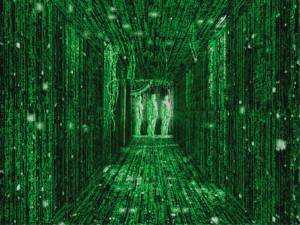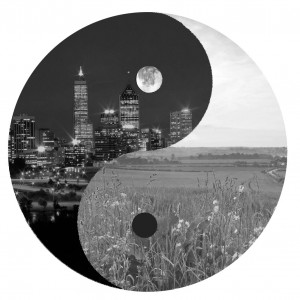Image: The Matrix Wallaper
Extract from: http://www.dan-dare.org
From the text of Manuel de Landa
Deleuze and The Genesis of Form
The essay we studied is an interpretation of Manuel de Landa (writer and artist) on the writings of the French philosopher Gilles Deleuze about the genesis of form.
According to De Landa, a constant in the history of Western philosophy, conceives matter as an inert element forms that come from the outside and not from the inside leaving aside the capabilities of the same shape and reducing the variability and the richness expression of matter at a gross concept of mass, in which only simple systems are studied in the same.
However, the author emphasizes the contrasting Gilles Deleuze’s work about Spinoza, in which a new possibility is discovered; resources or components involved in the genesis of the form (all elements) are forcefull for the generation of matter itself, defining the states in which matter is created from the inside out (not from outside) as imminent, ruling the collective behavior of the components and resulting in a geometric shape with divergent capabilities.
Likewise, Deleuze coined the term “divergent actualization” of the French philosopher Henri Bergson, distinguishing between “possible” and “real”, translating this to a network of forms or elements that together acquire a physical reality, I mean, an actualization that may differ from your starting point and ending point, depending on the differentiation of the same, creating a variation of different physical samples and always generating a genuine shape.
De Landa simplifies the complex Deleuzian’s thought coming from the Bergson’s theory, as follows: for Deleuze the “Noumena” (An existing world itself free of any human activity) is a part of the autonomous existence of real forms, which exists in synchrony with the virtual forms, making it is clear that the difference is not only diversity but also the difference is that by which the given is given, I mean, everything that happens (virtual and real) and all that appears is correlated with orders of differences: differences of level, temperature, intensity etc.
Therefore, Deleuze emphasizes the role of virtual singularities can only be captured during the genesis of form, before the final form one is updated and before the difference appears.
To clarify the above, the author points out the latest work of Deleuze, in which mention two very important types of structures “strata” and “self-consistent aggregates”, him refers to the strata as emergent elements through joining homogenous elements, while self-consistent aggregates emerging from the joint of heterogeneous elements. In both processes it is shown divergent actualizations of both the real and virtual form.
To end and completely clarify this text, I would like to define in a more austere way the above concepts. There are virtual diagrams that are possible through realities in the genesis of form. I mean, real processes such as the formation of a rock through layers or strata tends to settle through a “virtual” process to reach its final form, as well a society with different social “layers-strata” or actual roles, virtually settles in a variety of ranges or classification through a theological and legal codification. These virtual schemes or actualizations of shape merge the heterogeneous elements through an interposer agent forming new homogeneous networks and new possibilities.
Therefore, we can say that behind everything and every form is a virtuality or a process of strata and sedimentation forming a final shape through actualization and differentiation. As a personal topic, I would like to delve a little more to the last question posed by De Landa in his essay, “What is a novel or a painting or a piece of music” in this world?, As seen from the point of view of author, I understand the magnitude of the questions and new doubts as arise; Should be art a divergent actualization for society? Is the art and science two heterogeneous elements that should settle into a homogeneous one? Should be the art a real virtuality instead of a virtual reality? How could we reconceptualize the history through art and science?


